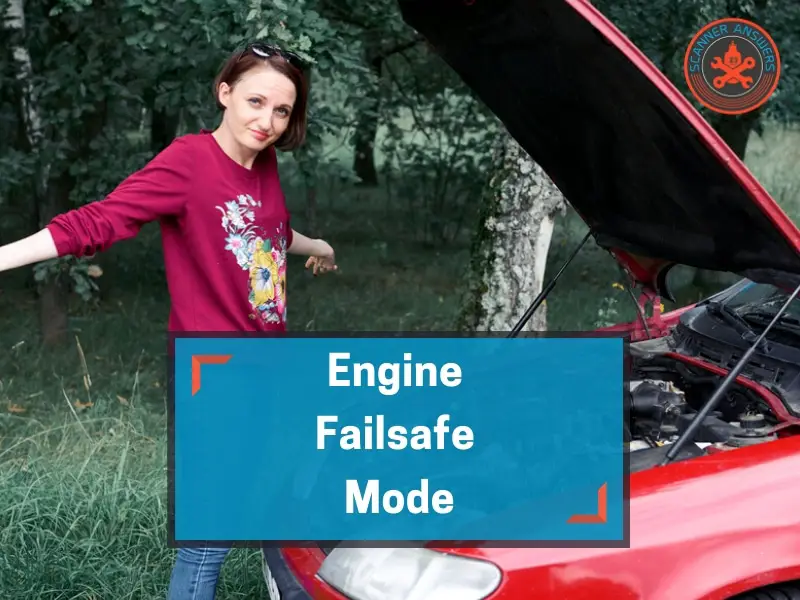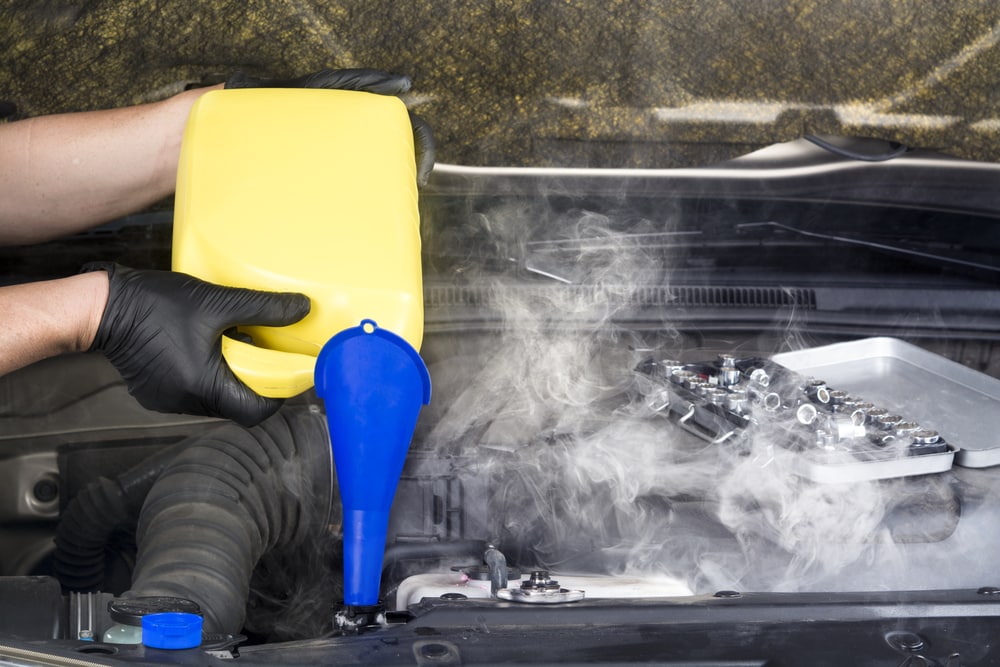Do you expect engine failsafe mode to have kicked in on your car or truck?
I know firsthand what it feels like if the engine (or the vehicle in general) is in fail-safe.
It’s not fun, but it’s not too bad either. You should be thankful for the failsafe mode or ‘limp mode’ feature in your car. Without glossing over the technical details, the failsafe mode is designed to prevent further engine and/or transmission damage.
In this article, I’ll discuss the basics of ETC Engine Failsafe Mode and how this affects the performance or drive-ability of your vehicle.

What is the engine failsafe mode?
When the vehicle’s computer (often called the Engine Control Module or ECM) detects a problem that could potentially cause damage to the engine or other critical components, it may trigger Engine Failsafe Mode as a protective measure.
Modern vehicles are governed by fast computers. New cars are equipped with multiple computers to analyze all vehicle systems. However, all the data are transferred and interpreted by the central ECM (engine control module).

What this means is the OBD2 diagnostic system in your vehicle is constantly on the prowl while it monitors ALL vehicle systems. This includes the fuel system, ignition, emissions, drivetrain, braking system, stability and traction control, throttle body, vehicle accessories, advanced safety systems, and much more.
Anything that has something to do with the above-mentioned systems will trigger the engine failsafe mode. The symptoms and causes will vary depending on the make and model of your vehicle. However, the meaning stays the same. If anything goes wrong with the various systems in the engine and/or transmission, limp mode will activate to protect the engine/tranny from further damage. It’s really that simple.
But what’s not simple is what triggers the engine failsafe mode. That’s a different matter altogether.
What causes limp or ETC failsafe mode?
In most cases, the check engine light will turn ON as the engine switches to failsafe mode. But having a check engine light does not necessarily mean the engine is in failsafe mode, and you should remember this when making a diagnosis. Although the symptoms of failsafe mode are hard to miss (and we’ll get to the symptoms in a bit), there are times the engine will enter limp mode even if the problem is not electrical or sensor-related by nature.
But to answer the question of what causes limp mode, it all depends on the type of vehicle, make and model, and the extent of the problem. Not all vehicles are alike.
When the check light illuminates, this could either mean a soft or hard trouble code. Grab your On-Board Diagnostics (OBD2) tool and plug it in to the 16-pin socket under your dash.
Soft Code
A soft OBD2 code is considered to be less harmful and less invasive than a hard code. Triggering a soft OBD2 code means the signal value of the faulty sensor is still within the preferred ‘outside range of the CPU.’ Most of the time, soft codes are caused by low priority sensors, which will also depend on the type of vehicle.
Hard Code
On the other hand, a hard code is triggered if the signal value from a high priority sensor is getting too far out of the acceptable outside range mentioned above.
This can mean that your transmission is going out or you have fuel injector failure.
When this happens, the ECU will revert to danger mode or secondary mode. For example, transmission problems with a hard code will disable the transmission from shifting gears. It may also default to a single usable gear to protect the failing component and the entire transmission in general. The same holds true if the engine is in secondary/survival mode. The engine speed will be governed so you don’t rev the engine too high to cause expensive damage.
And yes, hard codes are responsible for failsafe more or limp mode. So if you’re sure your vehicle is in limp mode, it is best to drive slowly and take it to a mechanic or service center immediately.

What are the symptoms of limp mode?
The symptoms will vary. Again, this has something to do with the make and model of your vehicle. But the general symptoms are hard to ignore.
- The CEL (check engine light) is ON
- The engine revs lazily and the transmission refuses to shift
- The throttle pedal will be stiffer than usual
- Other warning lights will also turn ON (oil, battery, temperature, etc.)
- The vehicle refuses to start
Regarding the no-start condition, some people consider this a curse, and I totally understand. But what they don’t know is a no-start condition in failsafe mode is actually a huge blessing. For all you know, the computer was merely doing its job in protecting the engine or transmission from further damage. And in most cases, vehicles that refuse to start in failsafe mode may be dealing with a serious mechanical-related issue.
Fail-Safe mode isn’t always bad (my story)
But it’s not always bad news!
My experience with the engine fail-safe mode is hilarious (looking back now).
It was a hot and humid day. The wife and I were conversing as the vehicle idles lazily in traffic. From out of nowhere, I felt a slight hiccup from the engine. It wasn’t violent or anything, but I did fell it. I also noticed a higher-than-usual idling speed and a check engine light in the console.
What came next is the temperature warning indicator. My wife’s car is not equipped with a manual temperature gauge, nor did it came with a digital temperature indicator. If the engine is overheating, you have a small red light to remind you.
The cars in front were moving ahead. By this time, the HVAC began blowing hot air inside the cabin. I shifted to D(rive) and pressed the gas pedal. The engine and the transmission felt miserly. The vehicle felt lazy. I drove slowly to the nearest pump station, got out of the car, and raised the hood to release the immense heat. It was there when I saw the coolant reservoir cap was open. The radiator is basically dehydrated as the water/coolant mixture basically drained away.
How I fixed it
Long story short, I got some clean distilled water (and I had a LOT) and replenished the reservoir. As the radiator siphoned the water from the reservoir, I added more. I did this until the temperature light turned OFF. I never opened the radiator cap, and neither should you if the engine is overheating.
Remember the part when the vehicle was acting lazily? That’s what failsafe mode feels like. Then transmission refuses to shift gears and the engine won’t rev as high as it used to be. In my case, the overheating engine was enough to trigger failsafe mode, and it saved my wife’s car from further damage.
Can I still drive a car in failsafe mode?
Yes!
The primary reason of failsafe mode is to allow you and the vehicle to literally limp your way home or towards a mechanic. But then again, the symptoms and behavior of a particular vehicle in limp mode will depend on the make and model of your vehicle. It also depends on the type of problem. But as a general rule, if the symptoms are obvious, then it generally needs immediate attention.
But you won’t be driving normally if the vehicle is in limp mode. In some vehicles, the speed limiter switches to 40 mph and won’t allow you to move faster than that. In my experience, it was mostly the transmission that acted weirdly. So why did a basic overheat trigger the transmission to act like this? The transmission fluid is routed to a separate row behind the radiator. As the radiator dried up, it didn’t have the ability to cool the transmission oil. This is the reason why the transmission (which happens to be a CVT) felt like it was starting from second or third gear. It lacked the ‘bite’ and the ‘grip’ that you feel when pulling from first gear.
But I was still able to drive the vehicle, although very slowly. I’m only glad that fail-safe mode did its job quite well. Kudos to modern technology!
If your vehicle enters Engine Failsafe Mode, it’s essential to address the underlying issue as soon as possible. Continuing to drive in this mode for an extended period can lead to further damage and more costly repairs.
How to reset engine failsafe mode?
This is where it gets complicated.
As we already discussed you have Soft Codes and Hard Codes. Soft Codes can be fixed by replacing the failing sensor and are usually not harmful. Hard Codes are indicative of a large problem and resetting them means replacing a transmission or engine.
An OBD2 tool with help you diagnose why your engine went into limp-mode.
Based on my story above, I was able to fix the problem by simply adding water to the reservoir.
As the engine cooled down, the temperature warning light turned OFF, but the check engine light is still ON. I waited for 10 minutes before turning the motor OFF. I pulled and reinserted the key and turned the engine back ON. The check engine light cleared. Again, breathed a heavy sigh of relief.
What I did was to search for the source of the problem using the clues presented to me. I wish cars would just say “Hey I need water!” or “My O2 sensor is failing, need help!” but it doesn’t work that way.
The primary clues were the engine hiccup, check engine light, and higher idling speed. Next came the temperature warning light. As I drove the car, the pedal felt stiff and the transmission felt lazy.
It all depends on the source of the problem!
Going through proper troubleshooting steps is your best bet to fixing limp mode. You can’t just clear the OBD2 code with your Bluedriver and move on! Robinsonsauto did a good video working on Limp Mode in a Ford 5.4 liter engine. Give it a watch below.
I have a friend who forgot to reinstall the engine breather tube. After starting the car and driving for a while, the check engine light came ON, followed by a lazy feeling in the engine. He drove back home and gave me a ring as the vehicle idled in his driveway. After I got there with my OBD2 scan tool we popped the hood and I noticed a hose missing. We reinserted the hose and the check engine light turned OFF.
Your best recourse may be to consult a mechanic. Even if you have an OBD2 scan tool, you may lack the knowledge to interpret the trouble codes to make a proper diagnosis. But if you’re lucky, the problem might only be caused by neglect or oversight.